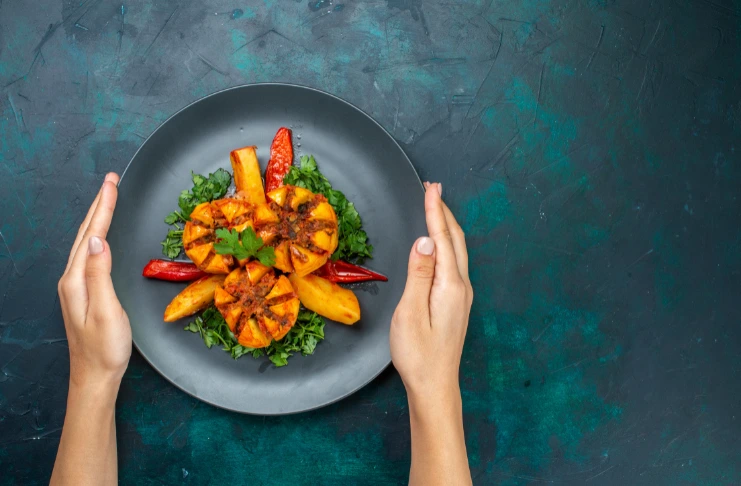
In a busy kitchen, great food presentation often takes a backseat to speed and flavor. When orders are flying in and the heat is on, it’s easy to focus on taste alone and push food plating down the priority list. But the truth is, how you present your food can make just as much of an impact as how it tastes, as food plating and presentation are crucial—especially in today’s image-driven dining culture.
You don’t need to be a professional chef or a trained artist to create plates that wow. With a few core food plating techniques, the right tools (yes, even squeeze bottles), and a little creativity, anyone can elevate their plating game.
In this blog, we’ll share simple and effective tips to help you make your food look as good as it tastes—from how to plate each course to using modern presentation styles.
The Basics of Food Presentation and Plating
Food presentation refers to the arrangement, styling, and overall visual design of a dish. It’s the practice of making food look as appetizing as it tastes, aiming to engage all five senses. Key Elements:
- Balance: Visual harmony between different components on the plate.
- Symmetry: Often used to create order and elegance.
- Color: Vibrant colors add contrast and excitement.
- Texture: Contrasting crispy, smooth, and soft elements keep things interesting.
- Proportion: Each element should have a defined place and purpose.
Plate Selection Matters:
The shape, size, and color of the plate can dramatically influence the final presentation. For example, white plates are preferred by many professional chefs because they provide a neutral canvas that makes the food pop.
Why Good Food Presentation Is Important
1. Attract Customers and Elevate the Experience
In restaurants, diners eat with their eyes first. A beautifully plated dish immediately creates anticipation. For instance, desserts served with artistic drizzles and garnishes increase perceived value.
2. Communicate the Quality of Your Restaurant
Consistent and well-thought-out plate presentation speaks volumes about your kitchen’s standards and professionalism. It reflects attention to detail in the finished plate , which customers equate with higher quality.
3. Essential for Restaurant Marketing
A visually appealing dish is a marketing asset. With Instagram and Yelp influencing dining choices, an impressive dish shared online becomes free promotion. Use squeeze bottles to create perfect sauce lines or dots that make your dish Instagram-ready.
Essential Tips for Attractive Food Presentation and Plating
1. Match with Your Restaurant Theme
Your plate presentation should feel like a natural extension of your restaurant’s brand. A rustic-themed bistro may favor wooden boards, earthenware, and organic plating styles, while a modern fine-dining venue might use sleek porcelain plates, geometric arrangements, and muted tones. The visual language of your food should complement the story you’re trying to tell.
If your menu is inspired by farm-to-table freshness, go for natural textures and edible garnishes. On the other hand, if you’re running a fusion concept, experiment with bold shapes and modern tools like squeeze bottles for precise drizzles and dots.
2. Choose the Right Tableware
- Material matters: Slate, ceramic, wood, and metal each create different moods.
- Shape and size: A large, flat tray can work well for shared appetizers; a deep bowl is perfect for layered pasta dishes.
- Style match: Rustic boards suit comfort food; polished white china fits fine dining.
- Example: A sizzling brownie looks more indulgent on a cast-iron skillet than on a plain white plate.
3. Choose the Right Plate
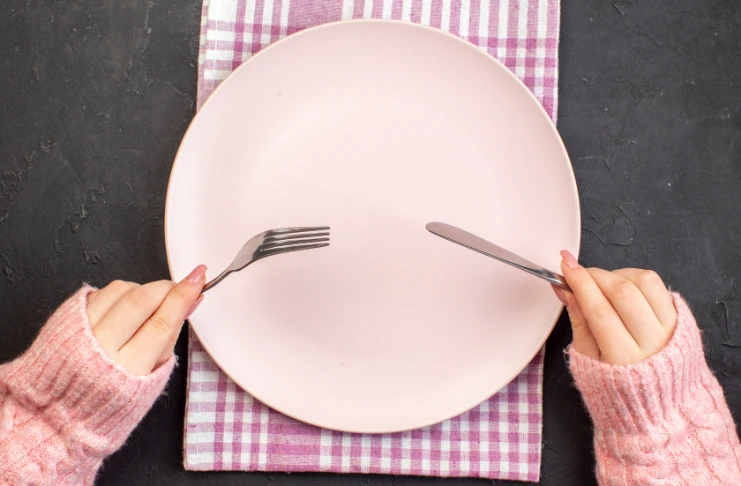
1. Size:
- Too small: Food looks cramped.
- Too large: Portions appear insubstantial.
- Ideal: Leave 1–2 inches of clean border space.
2. Shape:
- Round: Classic and safe.
- Oval/Rectangular: Great for creative or deconstructed plating styles.
3. Color:
- White: Enhances vibrant foods (e.g., beetroot hummus, rainbow salad).
- Black: Creates contrast and drama (ideal for light-colored sauces or foams).
- Pastel: Perfect for desserts or delicate seafood.
4. Focus on Portion Control
Less is often more when it comes to food plating. Overloading the plate can overwhelm the eye and make it hard to distinguish ingredients. Each component should have space to shine.
For example, if you’re serving steak with mashed potatoes and grilled asparagus, arrange them with gaps, not in a heap. Use a squeeze bottle to neatly add sauces and avoid flooding the plate. Clean space allows customers to appreciate the dish’s textures and colors—and makes your food look far more premium.
5. Use Color Contrast & Complementary Ingredients
Visual pop: Contrasting colors guide the diner’s eye and add excitement.
Natural contrasts:
- Salmon (orange) + pea purée (green) + crème fraîche (white)
- Beetroot (deep red) + goat cheese (white) + arugula (green)
6. Play with Height and Structure
Adding height creates visual interest and gives a more dynamic, professional chef feel. Stack components—like placing grilled vegetables vertically or leaning a crostini against a bowl of soup. Use ring molds for neat stacks of rice or salad. Be careful not to overdo it—unstable stacks can collapse and make service difficult. The goal is to add depth and sophistication, not complexity.
7. Use Complementary Colors
Borrow from the color wheel—opposites attract! For example, red and green or orange and blue work brilliantly. A tomato salad with basil leaves and a drizzle of balsamic is a classic example.
8. Garnish with Purpose
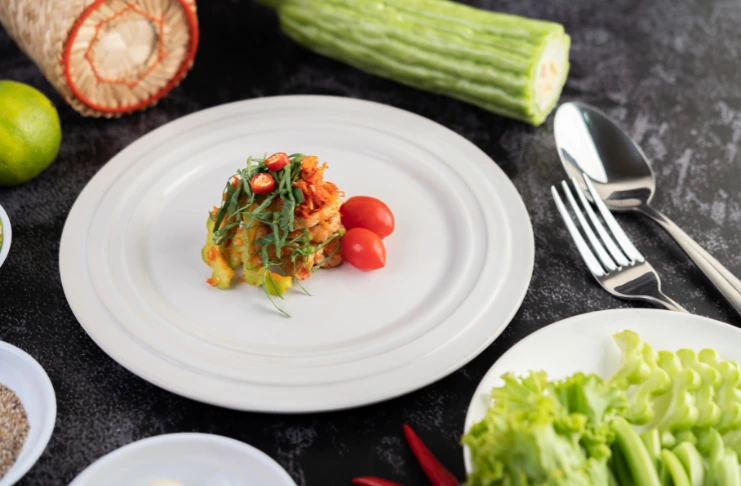
A garnish should never feel like an afterthought. Every element on the plate must be edible and purposeful. A sprinkle of microgreens can add freshness; a twist of lemon zest can enhance aroma; a drizzle from a squeeze bottle can tie flavors together.
Avoid decorative-only items like non-edible flowers or herbs that don’t match the dish. Think of the garnish as the final signature of your plate presentation—small but powerful.
9. Keep the Plate Clean
No smudges or drips: Wipe edges with a clean towel or paper napkin.
Use professional tools:
- Spoons for quenelles
- Squeeze bottles for sauces
- Tweezers for micro garnishes
Example: A clean white plate with a perfect sauce circle creates a fine-dining impression instantly.
10. Keep It Simple and Express Yourself
Simplicity doesn’t mean boring—it means intentional. Instead of crowding the plate with every possible element, focus on 2–3 ingredients and elevate them. Let your creativity shine, but always ask: “Does this add to the dish, or distract from it?”
Great plate presentation is about balance, restraint, and storytelling. Whether you’re plating a gourmet main or a comforting dessert, aim to make it visually compelling and true to your culinary identity.
INDUSTRY INSIGHT
A study published in the Research Journal of Food Science and Quality Control found a significant relationship between food presentation and customer retention in fast-food restaurants. Effective presentation strategies can lead to higher customer commitment and repeat patronage.
Exploring Plating Techniques by Course Like a Chef
1. Appetizers: Set the Tone with Elegance and Simplicity
Appetizers are your first chance to impress. The presentation should be clean and inviting, and hint at the quality and creativity of what’s to come. Since appetizers are usually small portions, you have the flexibility to experiment with negative space and bold contrasts without overwhelming the plate. Key plating techniques for appetizers:
- Use the rule of three: Odd numbers tend to be more visually appealing.
- Arrange in a shape: Triangular or circular layouts guide the eye.
- Add a flourish: A light drizzle of infused oil or a flavored purée adds sophistication.
2. Main Courses: Make the Protein the Hero
The main course is the centerpiece of the dining experience, and your plating should reflect that. In this course, balance is critical. You want to showcase the protein while ensuring the accompaniments support, rather than steal—the spotlight. Best practices for main course food plating:
- Center or offset the protein: It should be the visual anchor.
- Use base elements (like mashed potatoes or purées) as support: Swipe or spread them using the back of a spoon or spatula.
- Height adds impact: Lean sides or layer vertically to add structure.
- Apply sauce with precision: Use a squeeze bottle or small ladle to create controlled, intentional patterns.
3. Desserts: Use Flair and Playfulness
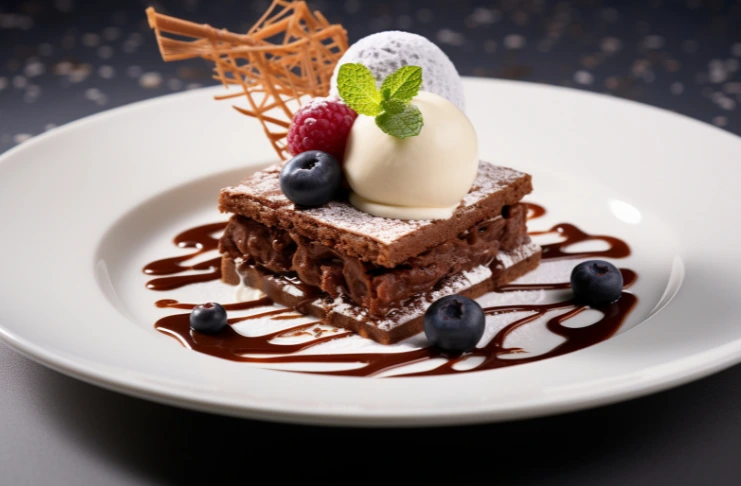
Desserts offer the most freedom in food presentation. This is your chance to be artistic, whimsical, and bold with textures, colors, and composition. Guests expect to be delighted, so bring in contrast, creativity, and a bit of surprise. Key plating techniques for desserts:
- Embrace asymmetry: Spread components across the plate for a deconstructed look.
- Layer textures: Crumbles, mousses, gels, and crisps add depth.
- Play with color: Bright coulis, edible flowers, and fruit garnishes bring life to the dish.
- Precision counts: Use piping bags or squeeze bottles to apply sauces or creams neatly.
Innovative Food Plating Styles to Inspire Your Creativity
1. Minimalist
The focus is on clean lines, negative space, and letting the hero ingredient command attention. The plate acts as a canvas, but instead of filling every inch, you leave room for the eye to breathe, creating a sophisticated and intentional aesthetic.
Key Techniques:
- Focus on a single centerpiece (usually the protein or main ingredient).
- Use no more than 2–3 additional elements.
- Leverage negative space to frame the food.
- Apply sauces with squeeze bottles to maintain clean lines and symmetry.
Why it works:
This style communicates precision, confidence, and a modern culinary approach. It’s commonly used in Michelin-starred venues where each ingredient must justify its place.
2. Rustic / Deconstructed
Rustic or deconstructed plating embraces imperfection and spontaneity. It’s about presenting ingredients in their raw, honest form while allowing diners to assemble bites their way. This style works beautifully for comfort food, farm-to-table cuisine, or dishes that spotlight wholesome, seasonal ingredients.
Key Techniques:
- Plate ingredients side-by-side instead of stacked or layered.
- Scatter garnishes or sauces in an organic, “effortless” way.
- Use wooden boards, stoneware, or clay plates for earthy presentation.
Why it works:
It feels approachable and artistic at the same time. This style connects with guests on an emotional level—it feels handmade, not manufactured.
3. Geometric / Abstract
Geometric or abstract plating is for the artist within the chef. This style borrows from architecture, painting, and sculpture to transform plates into modern canvases. Every element is precisely placed, with shapes and symmetry taking center stage.
Key Techniques:
- Use ring molds, tweezers, and squeeze bottles for maximum control.
- Focus on creating patterns with sauces and purées—dots, lines, arcs.
- Plate in linear, circular, or diagonal compositions.
- Prioritize consistency—this style requires precision and repetition.
Why it works:
It makes food feel elevated and sculptural. This is popular in avant-garde kitchens and for tasting menus, where diners expect both performance and precision.
4. Fusion Presentation Styles
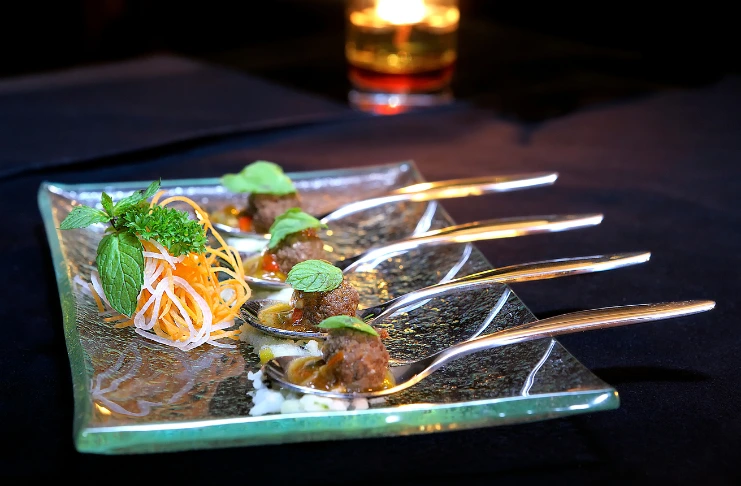
In fusion plating, the food is inspired by multiple cultures—and so is the plating. This innovative style breaks free from tradition and uses visual cues from around the world to build something new and exciting. It’s ideal for modern, globally inspired menus.
Key Techniques:
- Combine traditional elements (e.g., banana leaves, chopsticks, tortillas) with upscale presentation tools.
- Use international garnishes and sauces in new ways.
- Apply global ingredients with professional chef finesse.
Why it works:
It’s playful, bold, and engaging. Guests love the familiarity of flavors paired with a surprising, elevated look.
Common Food Plating Mistakes to Avoid
- Over-Garnishing: Too many herbs or decorative items distract from the main dish.
- Too Much Sauce: Drenching the plate in sauce can make it look messy. Instead, use plating techniques like dots or swooshes applied with a squeeze bottle.
- Lack of Focal Point: Every dish should have a hero ingredient. Avoid making all elements look equal in size and color.
- Ignoring Negative Space: Empty space enhances structure. Don’t try to cover the entire plate—let the food breathe.
Tools That Help You Plate Like a Pro
1. Squeeze Bottles
Squeeze bottles are essential for applying sauces with precision. Use them to create clean dots, lines, or swirls in savory and dessert plating. They offer control and consistency, helping you elevate food presentation effortlessly. They are a must-have for any professional chef aiming for refined and elegant plate presentation.
2. Ring Molds
Ring molds provide structure and symmetry on the plate. Perfect for stacking rice, Ring molds help you stack and layer components with clean, professional edges. They’re especially useful when plating dishes like tartare, risottos, layered salads, and desserts such as mousse or panna cotta. Best uses:
- Stacking avocado and tuna tartare into a perfect cylinder
- Creating molded rice or mashed potato towers for main courses
- Presenting layered desserts with sharp, geometric definition
3. Offset Spatulas
Offset spatulas are designed to lift and position delicate ingredients with precision. Their angled blade allows for smooth movements, making them great for transferring quenelles, spreading purées, or moving proteins. A staple in every professional chef’s plating kit, they ensure neatness and finesse on every plate.
4. Tweezers
Every professional chef knows that tweezers are not just for surgeons—they’re essential for high-end plate presentation. Long-plating tweezers help you place microgreens, herbs, edible flowers, seeds, or decorative crisps precisely, without smudging the plate or disturbing other elements. Best uses:
- Positioning microgreens atop a scallop or canapés
- Adding edible petals to a dessert or cocktail garnish
- Fixing finishing touches like gold leaf, salt flakes, or powders
Bonus: Instagram-Worthy Presentation Tips
In the age of food influencers, plating has gone digital. Here’s how to make dishes social-media ready:
- Lighting: Use natural light or soft white light to make colors pop.
- Angles: Top-down for flat dishes, 45-degree for stacked elements.
- Props: Use wooden boards, marble backdrops, and neutral cutlery.
- Final Touches: Use squeeze bottles for a finishing drizzle or dots that add flair.
Conclusion
Great food presentation begins with intention, balance, and thoughtful creativity. Whether you’re a professional chef or a passionate home cook, learning the fundamentals of food plating—from plate selection to portioning, structure, and color contrast—can elevate every dish you serve. Tools like squeeze bottles bring precision, while plating techniques help you highlight the essence of each ingredient.
When done well, presentation enhances a dish’s appearance and enriches its experience. Let your plating reflect your culinary identity and the story you want to tell. With a few simple yet deliberate choices, you can transform a good meal into a memorable one.
Frequently Asked Questions
A great example of professional food presentation is pan-seared salmon served on a vibrant pea purée, with roasted baby carrots arranged diagonally and a drizzle of lemon beurre blanc added using a squeeze bottle. Garnish with microgreens for a clean, elegant finish.
To display food properly on a plate, follow structured plating techniques: place the protein as the focal point, add sides with balance, incorporate sauces thoughtfully, and use garnishes that enhance flavor and appearance.
Arrange food by using the rule of thirds or the clock method. Imagine the plate as a clock: protein at 6 o’clock, starch at 10, and vegetables at 2. This classic approach helps maintain symmetry and creates a professional look.
The five essentials of great food plating are:
- Balance – between components and flavors
- Color – for visual appeal
- Texture – combining crunchy, smooth, etc.
- Proportion – the right portion size for each item
- Height – adds dimension and interest
The best way to present food is to choose the right plate, use professional chef tools like squeeze bottles for sauces, ensure color contrast, avoid overcrowding, and keep the plate clean. Let each component have space to shine.
Use visual harmony by matching your dish’s style with the plate. Employ plating techniques like layering or fanning ingredients, add height, and use color contrast. Keep the layout simple yet elegant.
Food presentation techniques involve strategic arrangement of food using visual elements like height, color contrast, negative space, and texture. Tools like tweezers and squeeze bottles help in creating fine details that define a dish’s appeal.
Start with plate selection based on your dish and theme. Next, plan your layout—know where your main item, sides, and sauces will go. Use professional chef tools and ensure every element is prepped for clean placement.
- Use the right-sized plate
- Highlight one main ingredient
- Add height or structure
- Use sauce art with squeeze bottles
- Include texture variety
- Balance colors
- Keep the presentation minimal and clean
To present attractively, aim for a focal point, complement colors and textures, and consider techniques like free form plating. , and arrange components thoughtfully. A swirl of sauce or a well-placed garnish can make a dish look plated by a professional chef.
Describe it by noting the visual composition: the use of color, spacing, plate shape, garnish placement, and how the elements are balanced. You might say, “The dish features vertical food plating with contrasting hues and minimal garnish for sophistication.”
Serve food with a confident hand, clean plate edges, and a smile. If appropriate, introduce the dish by mentioning the hero ingredient and any standout preparation or garnish technique, especially if it involves specialty plating techniques.
Introduce a new dish by highlighting the inspiration behind it, key ingredients, and presentation style. For example, “Our new entrée features slow-roasted lamb, plated with harissa jus using squeeze bottles, and paired with mint labneh for balance.”








